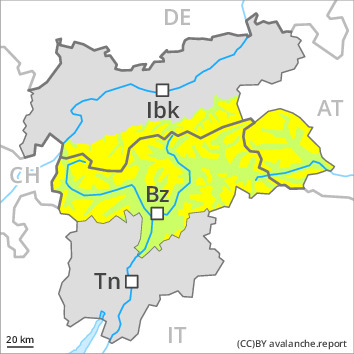
Danger level
 | 2200m |
|  |
|  | ||||
|  |
|  |

Weakly bonded old snow is to be avoided. Wind slabs are to be evaluated with care and prudence.
Weak layers in the old snowpack can still be released in very isolated cases by individual winter sport participants, in particular on very steep shady slopes above approximately 2200 m, as well as on steep sunny slopes in high Alpine regions. In very isolated cases avalanches can also reach large size. Isolated whumpfing sounds can indicate the danger. The number and size of avalanche prone locations will increase with altitude. In particular transitions from a shallow to a deep snowpack are unfavourable. Very steep shady slopes are to be traversed by snow sport participants one at a time.
In addition the clearly visible wind slabs should be taken into account. These are mostly only small but in some cases prone to triggering. Avalanche prone locations are to be found in particular in gullies and bowls, and behind abrupt changes in the terrain and in shady places that are protected from the wind above approximately 2200 m.
On very steep sunny slopes individual gliding avalanches and moist snow slides are possible as the day progresses.
Snowpack
dp.7: snow-poor zones in snow-rich surrounding
dp.6: cold, loose snow and wind
Faceted weak layers exist in the centre of the snowpack, in particular on shady slopes above the tree line, as well as on sunny slopes in high Alpine regions. In areas where the snow cover is rather shallow the likelihood of avalanches is higher. Snow profiles and stability tests confirm the unfavourable bonding of the snowpack in these altitude zones.
In addition the fresh wind slabs are prone to triggering in some locations. They are poorly bonded with the old snowpack in particular on shady slopes. Wind slabs are mostly only small.
As a consequence of mild temperatures and solar radiation the snowpack consolidated. As a consequence of rising temperatures and a crust formed on the surface during the last few days, especially on steep sunny slopes below approximately 2400 m, as well as in all aspects at low and intermediate altitudes. Snow depths vary greatly above the tree line, depending on the infuence of the wind.
Tendency
The weather conditions will foster a slow strengthening of the near-surface layers. The danger of dry avalanches will decrease gradually. On shady slopes the situation is less favourable.

